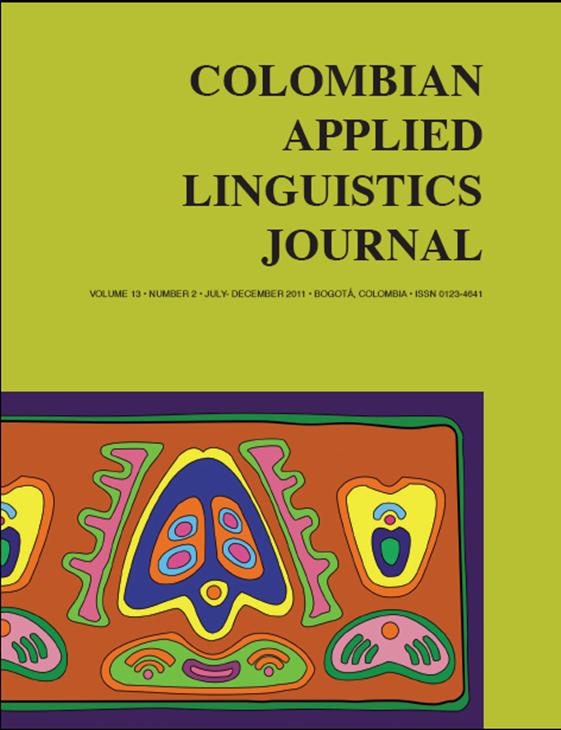DOI:
https://doi.org/10.14483/22487085.3764Published:
2011-07-01Issue:
Vol 13, No 2 (2011) July-DecemberSection:
Research ArticlesThe motivational properties of emotions in foreign language learning
Las propiedades motivacionales de las emociones en el aprendizaje de una lengua extranjera
Keywords:
afectividad, emociones, aprendizaje de lenguas, motivación (es).Keywords:
affect, emotions, language learning, motivation (en).Downloads
Abstract (en)
Although the process of learning a foreign language is replete with emotions, these have not been sufficiently studied in the field of English Language Teaching. The aim of this article is to report the motivational impact of the emotions experienced by second year students of an English Language Teaching programme in a South East Mexican University. Students were asked to keep an emotional journal for twelve weeks during their third term in order to map their emotions and their sources during instructed language learning. The results show that the emotions experienced most by students are: fear, happiness, worry, calm, sadness and excitement. Although there is a range of sources for emotional reactions, the five main sources of students’ emotions are: their insecurity about their speaking ability, the teachers’ attitudes, comparisons with peers, the classroom atmosphere, and the type of learning activities.The two main aspects identified as impacting on students’ motivation are: the teachers’ attitudes, and the classroom climate.
Abstract (es)
Aunque el proceso de aprendizaje de una lengua extranjera está lleno de emociones, estas no han sido suficientemente estudiadas en el campo de la enseñanza del inglés. El propósito de este artículo es reportar el impacto motivacional de las emociones experimentadas por estudiantes de segundo año de la licenciatura en Lengua Inglesa en una universidad del sureste Mexicano. Los estudiantes plasmaron en un diario las diversas emociones experimentadas así como sus reacciones durante doce semanas en el tercer semestre de su carrera con el propósito de mapear sus emociones y las fuentes de éstas durante la instrucción en el aula. Los resultados muestran que las emociones más recurrentes durante la instrucción son: miedo, alegría, preocupación, tranquilidad, tristeza y entusiasmo. A pesar de que hay diversas fuentes que originan estas emociones, los cinco orígenes principales de éstas son: la inseguridad al hablar en inglés, las actitudes de los profesores, la comparación con sus compañeros, el ambiente en el salón de clases y el tipo de actividades de aprendizaje. Los dos aspectos identificados como los que influyen más en la motivación de los estudiantes son: las actitudes de los profesores y el ambiente de aprendizaje.
References
Aki, O. (2006). Is emotional intelligence or mental intelligence more important in language learning? Journal of Applied Sciences, 6 (1), 66-70.
Arnold, J. (2009). Affect in L2 learning and teaching. Estudios de Lingüística Inglesa Aplicada, 9, 145-151.
Arnold, J. (Ed.). (1999). Affect in language learning. Cambridge: Cambridge University Press.
Arnold, J., & Brown, D. H. (1999).A map of the terrain.In J. Arnold (Ed.), Affect in language learning (pp. 1-24). Cambridge: Cambridge University Press.
Barbour, R. (2008).Introducing qualitative research: A student guide to the craft of doing qualitative research. London: Sage.
Bailey, K. M. (1983). Competitiveness and anxiety in adult second language learning. In H. W. Seliger & M. H. Long (Eds.), Classroom oriented research in second language acquisition (pp.67-102).New York: Newbury House.
Bandura, A. (1997).Self-efficacy: the exercise of control. New York: W. H. Freeman and Company.
Bown, J. & White, C. J. (2010) Affect in a self-regulatory framework for language learning. System, 38 (3), 432-443.
Blumenfeld, P. C. (1992). Classroom learning and motivation: clarifying and expanding goal theory. Journal of Educational Psychology, 84(3), 272-281.
Carole, A. (1992). Classrooms: Goals, structures and students motivation. Journal of Educational Psychology, 84(3), 267-271.
Covington, M. V. (1992) Making the grade: a self-worth perspective on motivation and school reform. Cambridge: Cambridge University Press.
Deci, E. L., &Ryan, R. M. (1985). Intrinsic motivation and self-determination in human behaviour. New York: Plenum.
Dewaele, J. M. (2005). Investigating the psychological and emotional dimensions in instructed language learning: Obstacles and possibilities. The Modern Language Journal, 89(3), 367-380.
Do, S. L., &Schallert, D. L. (2004). Emotions and classroom talk: Toward a model of the role of affect in students’ experiences of classroom discussions. Journal of Educational Psychology, 96(4), 619-634.
Dörnyei, Z. (1994). Motivation and motivating in the foreign language classroom.The Modern Language Journal, 78(3), 273-284.
Dörnyei, Z. (2001). Motivational strategies in the language classroom. Cambridge: Cambridge University Press.
Dörnyei, Z. (2005). The psychology of the language learner: Individual differences in second language acquisition. Mahwah, NJ: Lawrence Erlbaum.
Dörnyei, Z. (2009). The L2 motivational self system. In Z. Dornyei, & E. Ushioda, (Eds.),Motivation, language
identity and the L2 self (pp. 9-42).Clevendon: Multilingual Matters.
Efklides, A., &Volet, S. (2005). Emotional experiences during learning: multiple, situated and dynamic. Learning and Instruction, 15(5), 377-380.
Ekman, P. (2003). Emotions revealed: Understanding faces and feelings. London: Weidenfeld& Nicolson.
Ellis, R. (1994). The study of second language acquisition. Oxford: Oxford University Press.
Erickson, E. H. (1968). Identity, youth and crisis. New York: Norton.
Fridja, N. H. (1988). The laws of emotion.American Psychologist 43(1), 349-358.
Forgas, J. P. (2001) Handbook of Affect and social cognition. London: Erlbaum.
Gage, N., &Beliner, D. (1992).Educational psychology (5th ed.). Boston: Houghton Mifflin.
Gardner, R. C. & Lambert, W. E. (1972). Attitudes and motivation in second language learning.Rowley, Massachusetts: Newbury House Publishers.
Garret, P. & Young, R. F. (2009) Theorizing affect in foreign language learning: an analysis of one learner’s responses to a communicative Portuguese course. The Modern Language Journal, 93 (2), 209-226.
Gläser-Zikuda, M., &FuB, S. (2008).Impact of teacher competencies on student emotions: A multi-method approach. International Journal of Educational Research, 47(2), 136-147.
Gläser-Zikuda, M., Fuß, S., Laukenmann, M., Metz, K., &Randler, C. (2005).Promoting students’ emotion and achievement -instructional design and evaluation of the ECOLE-approach.Learning and Instruction, 15(5), 481-495.
Gläser-Zikuda, M., &Järvelä, S. (2008).Application of qualitative and quantitative methods to enrich understanding of emotional and motivational aspects of learning.International Journal of Educational Research, 47(2), 79-83.
Graves, K. (2005). Designing language courses: A guide for teachers. Beijing, China: Foreign Language Teaching and Research Press.
Hascher, T. (2007).Exploring students’ well-being by taking a variety of looks into the classroom.Hellenic Journal of Psychology, 4(3), 331-349.
Hascher, T. (2008). Quantitative and qualitative research approaches to assess student well-being. International Journal of Educational Research, 47(2), 84-96.
Immordino-Yang, M. H. &Damasio, A. (2007) We feel, therefore we learn: the relevance of affective and social neuroscience to education. Mind, Brain and Education,1(1), 3-10.
Imai, Y. (2010) Emotions in SLA: New insights from collaborative learning for an EFL Classroom. The Modern Language Journal, 94 (2), 278-292.
Jackson, J. (2002). Reticence in second language case discussions: Anxiety and aspirations. System, 30(1), 65-84.
Jacobs, B. (2004). Writing for emotional balance: A guided journal to help you manage overwhelming emotions.
Oakland, CA : New Harbinger Publications.
Jensen, E. (2005). Teaching with the brain in mind. Alexandria, VA: ASCD.
Lei, Q. (2007). EFL teachers’ factors and students affect. US-China Education Review, 4(3), 60-67.
Littlewood, W. (2000). Do Asian students really want to listen and obey? ELT Journal, 54(1), 31-35.
MacIntyre, P. (2002). Motivation, anxiety and emotion in second language acquisition. In P. Robinson (Ed.), Individual differences and instructed language learning (pp. 45-68). Amsterdam: John Benjamins Publishing
Meyer, D. K., & Turner, J. C. (2006). Re-conceptualizing emotion and motivation to learn in classroom contexts.Educational Psychology Review, 18 (14), 377-390.
Turner, J. C., Meyer, D. K., &Schweinle, A. (2003). The importance of emotion in theories of motivation: Empirical, methodological and theoretical considerations from a goal theory perspective. International Journal of Educational Research, 39(4-5), 375-393.
Pekrun, R. (2000). A Social-Cognitive, Control-Value Theory of Achievement Emotions. Amsterdam: Elsevier Science B.V.
Pekrun, R., Goetz, T., Titz, W., & Perry, R. P. (2002). Academic emotions in students’ self-regulated learning and achievement: a program of qualitative and quantitative research. Educational Psychologist, 37(2), 91-105.
Sansone, C., &Thoman, D. B. (2005). Does what we feel affect what we learn? Some answers and new questions.Language and Instruction, 15(5), 507-515.
Scherer, K. R. (2005). What are emotions? And how can they be measured? Social Science Information, 44(4), 695-729.
Schumann, J. H. (1998). The neurobiology of affect in language. Oxford: Blackwell.
Schutz, P. A., &DeCuir, J. T. (2002). Inquiry on emotions in education.Educational Psychologist, 37(2), 125-134.
Tse, L. (2000). Student perceptions of foreign language study: A qualitative analysis of foreign language autobiographies. The Modern Language Journal, 84(1), 69-84.
Weiner, B. (1992).Human motivation: metaphors, theories and research. Newbury Park, CA, Sage.
Williams, M., Burden, R., Poulet, G., & Maun, l. (2004). Learners’ perceptions of their successes and failures in foreign language learning.Language Learning, 30(1), 19-29.
Williams, M., & Burden, R. L. (1997).Psychology for language teachers: A social constructivist approach. Cambridge: Cambridge University Press. Xie, X. (2010). Why are students quiet? Looking at the Chinese context and below.ELT Journal, 64(1), 10-20.
Yan, J. X., & Horwitz, E. K. (2008).Learners’ perceptions of how anxiety interacts with personal and instructional factors to influence their achievement in English: A qualitative analysis of EFL learners in China. Language Learning, 58(1), 151-183.
Zhang, X., & Head, K. (2010).Dealing with learner reticence in the speaking class.ELT Journal, 64(1), 1-9.
How to Cite
APA
ACM
ACS
ABNT
Chicago
Harvard
IEEE
MLA
Turabian
Vancouver
Download Citation
Metrics
License
This work is licensed under a Creative Commons Attribution-NonCommercial-NoDerivatives 4.0 International License.
Attribution — You must give appropriate credit, provide a link to the license, and indicate if changes were made. You may do so in any reasonable manner, but not in any way that suggests the licensor endorses you or your use.
NonCommercial — You may not use the material for commercial purposes.
NoDerivatives — If you remix, transform, or build upon the material, you may not distribute the modified material.
The journal allow the author(s) to hold the copyright without restrictions. Also, The Colombian Apllied Linguistics Journal will allow the author(s) to retain publishing rights without restrictions.













.JPG)










